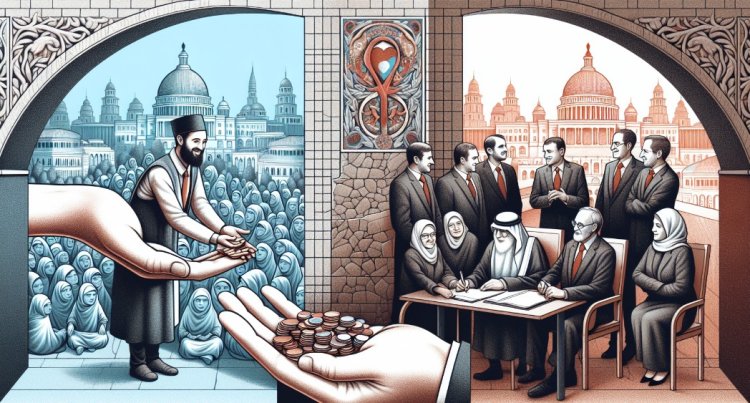The Rise of Hamas: From Charity to Political Power
"Explore 'The Rise of Hamas: From Charity to Political Power,' a detailed analysis of Hamas's evolution. This article delves into the organization's transition from its charitable beginnings to a significant political force, examining its impact on regional politics and global perceptions."

The Birth of the Muslim Brotherhood
Let us now look at the city of Ismailia in Egypt, which lies on the Suez Canal. The Muslim Brotherhood, a powerful group, was founded here in 1928. Hassan al-Banna founded the Muslim Brotherhood in the early 1900s to help the Arab nations that were suffering from poverty. They rejected Western values and advocated a return to traditional Islamic principles.
The Brotherhood's main goal was to create a government that followed Islamic law. In the 1940s, they established schools, hospitals, businesses, and mosques to improve the poor living conditions caused by British colonialism.
The Muslim Brotherhood expands
The Muslim Brotherhood also had influence outside of Egypt. In the 1940s, they grew up on Egypt's Sinai Peninsula, which bordered Israel and the Gaza Strip. The Brotherhood didn't agree with the UN's decision to partition Palestine. When the Arab-Israeli war began in 1948, 10,000 members of the Brotherhood decided to fight against Israel.
In the 1950s, the Brotherhood repeatedly opposed Israel in various ways, e.g., by organizing strikes and protests and trying to influence diplomacy. In 1959, Egypt took control of the Gaza Strip, which helped the Brotherhood establish itself in the region and build strong ties.
The Emergence of Hamas
In 1967, Israel took control of the Gaza Strip and the West Bank, which exacerbated tensions. During this time, Sheikh Ahmed Yasin, a Palestinian religious leader and refugee from the Arab-Israeli war, founded a charity organization called Mujama Al-Islamia. It was linked to the Muslim Brotherhood. Many people say that this group was formed before Hamas.
The Israeli government officially registered Yasin's charity in 1978. It supported social services, schools, and mosques. Initially, the Israeli government was not really interested in the Mujama. Perhaps it wanted to support a more peaceful group than the Palestine Liberation Organisation (PLO), which was fighting against Israel.
Mujama transforms into Hamas.
In the mid-1980s, there were signs that the Mujama had begun to take part in armed fighting. In 1984, Israeli soldiers broke into one of their mosques and said they had found a pile of weapons. The leader of the group, Sheikh Yasin, was taken into custody for collecting weapons and ammunition.
In the late 1980s, the Mujama Charity Organisation controlled 40% of the mosques in Gaza. It continued to behave as a peaceful group, but that soon changed. In 1987, there was a major uprising, the First Intifada. During this time, many people protested and rioted against Israeli control. Six members of the Muslim Brotherhood met in Sheikh Yasin's house and formed a group called Hamas, also known as the Islamic Resistance Movement.
Hamas Enters the Political Arena
Hamas began as a group that used weapons to fight others, but it also wanted to be seen as a legitimate political group and have the power within institutions. In 2006, Hamas surprisingly won the most seats in Gaza's parliamentary elections. Ismail Haniyeh, a member of Hamas, became the leader of the Gaza Strip. This led to a split between Fatah, which controlled the West Bank, and Hamas in Gaza.
Hamas' victory and takeover of Gaza caused a period of unrest and further deteriorated relations with Israel. Different countries have different opinions about Hamas. Some countries considered Hamas a terrorist group, while others saw it as a serious political option.
Hamas's Influence and Challenges
Hamas had to struggle with many difficulties during its time in power in Gaza. It had to reconcile government work, the provision of social services, and the maintenance of armed resistance against Israel. Israel restricted the movement of money and goods, which made the situation even more difficult for the Palestinians. This led to money problems and made people unhappy.
Hamas faced difficulties but managed to survive and changed its official rules in 2017. The change showed that Hamas is now open to the idea of a Palestinian state within the 1967 borders. The organization is still involved in the Israeli-Palestinian conflict, which is characterized by ongoing tensions and sporadic outbreaks of violence.
The complex story of Hamas
The story of how Hamas went from being a charity organization to a political group is complicated and causes disagreement. It spans many years and involves various things that have happened in the past, struggles, and changes of ideas. People have tried to find a peaceful solution to the conflict between Israel and Palestine, but it is still not resolved. Hamas is still an important player in the region.
Conclusion
Hamas began as a charity organization and became a powerful political group. This shows how complicated the Israeli-Palestinian conflict is. Hamas began with the Muslim Brotherhood and the problems of the Palestinian people. However, its path was influenced by past events, political situations, and conflicts within the organization.
To truly understand the Israeli-Palestinian conflict and the difficulties of achieving lasting peace, it is important to know how Hamas came to power.



 admin
admin 










